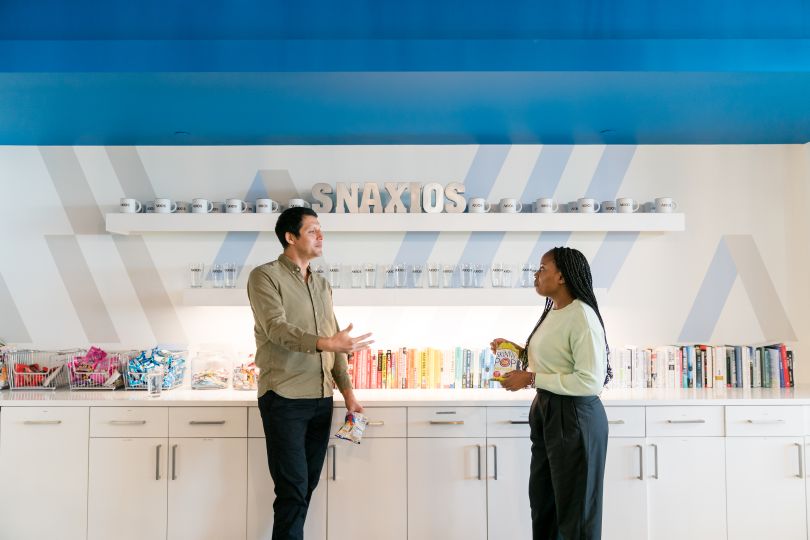Reporters might be the ones delivering news to readers, but behind the scenes are indispensable team members who play an equally vital role in ensuring content reaches the audience.
In today’s digital news age, that team includes technologists like Axios’ VP of Engineering Jamie Talbot, who leads a team of engineers building the upstart media company’s websites, newsletters and apps.
Talbot joined the upstart media company in 2021, bringing with him experience from prior engineering roles at companies such as Mailchimp and Medium, where he served as principal engineer and engineering director, respectively.
“First and foremost, it was important to me to spend my time working on a mission that mattered,” Talbot said. “‘Make people smarter, faster’ is the kind of thing I’m happy to lend my efforts to.”
In the time that he’s been with Axios — which Cox Enterprises acquired in a major deal last year — expansion of its product offering has required technical dexterity from his team.
“It was — and is! — an exciting time for Axios as we expand from sending national newsletters to a much broader set of offerings,” Talbot said. “For example, we added a ‘Local’ product with journalists in dozens of cities across the country, and a ‘Pro’ product offering premium journalism that gives businesses a competitive edge. Those new offerings demanded an updated technical strategy, modern development processes and a team reorganization so we could deliver them in parallel.”
Below, Talbot shared how he leads his colleagues while unpacking the values that guide both Axios’ technical endeavors and its approach to building a team.

What’s your style of leadership?
I believe in a model of servant leadership where the primary job of managers and leaders is to unblock and provide opportunities for individual contributors to do their best work.
I guide and advise more than directly specifying things. I delegate a lot of process work to engineering managers, and technical decision making to those who are closer to the actual building. To enable that, I try to create a high-trust environment, where folks feel confident enough to make good decisions without constantly having to ask for permission.
From a practical standpoint, I do this by distilling philosophy down into fragments that we call “Engineering Axioms.” These are designed to be short, memorable and clarifying, like “bias to action”; “quality is everyone” or “never tolerate flaky tests.” The idea is that folks can use these to guide them in the dozens of decisions they have to make every day.
What does the team culture look like at Axios? Why is that important for the work that you do?
I believe in the power of diverse teams to create compelling products, especially when they are built for a mass audience. We only get the benefit of that when folks can actually bring their different experiences and perspectives, rather than trying to tailor their contributions so they don’t rock the boat. It’s important to me that folks feel comfortable bringing as much of themselves to work as they want.
“I believe in the power of diverse teams to create compelling products, especially when they are built for a mass audience.”
We look for three broad things when we’re hiring: the ability to build software, the ability to learn and teach, and alignment with our values. We break those down into 15 areas. Outside of things like system design and coding ability, we pay attention to things like curiosity, empathy, determination and self-awareness.
We try to make the interview process as inclusive and humane as possible. We do have a take-home test, but it’s sized so it really can be completed in a couple of hours. (Too many take-home tests are open-ended “impress us” exercises, which disproportionately favor those who have plenty of time to work on them.) We then have a virtual panel where each interview is designed to provide a signal in a handful of our 15 criteria.
My favorite is our “work history” interview, which asks a standard set of questions about each of the candidate’s last three roles. It’s designed to understand a candidate’s professional skills, their motivations, how they view others and other characteristics that are critical to working in a modern, remote team. Many candidates remark that they’ve never had an interview like it, and it’s really helped us build a strong team of resilient, collaborative, growth-minded people.
We train all our interviewers, reminding them of power dynamics and implicit bias, and don’t let them interview on their own until they’ve observed a couple of interviews, and been observed conducting a couple.

How do you help your team grow their careers? What tools and support do you offer to allow them to stretch their skills?
A common problem with a team of high-potential folks is that there aren’t enough leadership positions. We have tech leads and guild leads, but these are typically occupied by senior engineers.
When you orient your teams around products and customers, there are also certain technical areas that are important, but aren’t clearly owned by any specific team.
To solve both these problems, we have the concept of “Roles.” A Role has a set of active responsibilities, and a handful of metrics to improve. We define Roles as we find a need for them, and like to give them fun names like “On-Call Czar” or “Scalability Frood.”
Ideally these Roles are filled by mid-level engineers. This gives them the opportunity to build a roadmap, convene stakeholders, get buy-in, delegate work and report progress on projects that are typically important but not urgent. This prepares them for stepping into team leadership when the opportunity arises.
With servant leadership, one of our managers’ primary responsibilities is to understand each person’s goals and to work with team leads to create opportunities for them to stretch in those areas.
Because we do matrixed management, that manager relationship can be very long-lived, surviving promotions and team changes, which is important in a dynamic organization where we change as we learn more.
What is something exciting that you are currently working on with your team?
We’re in the middle of a significant technical transformation that will support Axios’ ambitions. We’re removing GraphQL from our stack and moving to a unified gRPC API (with a RESTful gateway) that supports both web and mobile on an equal footing. We consolidated all our web code into one modern React service. We harmonized our environments so that dev is as close to production as possible, differing only in environment variables. And we put all of it in a monorepo that is automatically and continuously deployed on merge, which was a huge change from the prior process of one deploy per week.
One unique thing is an internal environment called Inside, which is the same Axios site, but written by Axions for Axions. It’s a dogfooding environment, but also a place for us to share company news, technical ideas, book reviews, life news, recipes, conference reports or anything else that’s interesting. It’s already one of my favorite things to read and really brings home how interesting and thoughtful our team is.







